
Have You Herd?
Cow rescue is a haven for heifers



Have You Herd?
Cow rescue is a haven for heifers

By Shirley Bloomfield, CEO NTCA–The Rural Broadband Association
Money raised by a small fee on your communications bill makes a critical difference throughout rural America. Earlier this year, a ruling by the U.S. Supreme Court allowed the Universal Service Fund, or USF, to continue.
I can’t emphasize enough how critical this ruling is in a journey that began in 1934, when the Communications Act decreed all Americans should have access to rapid, efficient and nationwide communication services at reasonable prices.
Then, the 1996 Telecommunications Act created the USF to better connect rural areas and make voice and broadband services more affordable for rural and low-income consumers, schools, libraries and rural health care facilities.
By affirming that the Federal Communications Commission has discretion to collect the fees, the court kept this foundational tool in place. A March survey of nearly 270 NTCA members indicated that the USF programs help keep rural broadband rates more affordable. Without this funding, rural consumer rates could be more than double those in urban areas.
Policymakers in Washington, D.C., are debating how to reform universal service programs going forward, so that they can continue to serve the needs of millions of Americans.
It is essential that our elected officials understand the positive impacts the critical USF programs have had—and continue to have—on the availability, affordability and sustainability of voice and broadband services for millions of consumers, businesses and anchor institutions in rural America. Visit ntca.org/universalservice.

While October is National Cybersecurity Awareness Month, protecting yourself requires year-long vigilance. And everyone’s needs vary based on the online tools and resources you use.
Remember, bad actors are increasingly sophisticated—they want access to your information. The FBI offers a few tips for some of the key points of emphasis, and they provide a good starting point for planning your personalized security strategy.
Create a sturdy defense. Update systems, software and apps. Also, install a strong, reputable antivirus program.
Connect carefully. Be cautious when connecting to a public Wi-Fi network. Avoid sensitive transactions, including purchases. Create a strong and unique passphrase for each online account.
Lock down all accounts. Establish multifactor authentication. Examine the email address in all correspondence and scrutinize website URLs before responding to a message or visiting a site. Don’t click on anything in unsolicited emails or text messages.
Guard your information. Be cautious about your information in online profiles and social media accounts. Sharing the names of pets, schools and family members gives scammers hints they need to guess your passwords or the answers to your account security questions. Never send payments to unknown people or organizations, particularly those urging immediate action.
Story by LES O’DELL
Farmers, ranchers, shepherds and homesteaders work to raise crops and livestock as efficiently as possible. Like any business, the goal is to maximize income and profitability.
Yet many agriculturalists also see themselves as conservationists, working to preserve the past while ensuring the future by using Earth-friendly farming methods and raising animals facing extinction.
In Pikeville, Tennessee, Amy Balog and her family raise endangered agricultural animals, also called heritage livestock breeds. “There are so many reasons why,” she says. “It’s not only keeping the genetics going. It’s the history and provenance of the breeds.”
Her Faverolles chickens, Sebastopol geese and Saxony ducks are among 180 breeds listed on the Conservation Priority List, an annual ranking of farm animals on the brink of disappearing. The list includes varieties of 11 different animals, from rabbits to cattle, horses and hogs. Many breeds fall out of favor in commercial agricultural settings. Perhaps they don’t put on weight as quickly as other breeds, for example. But they still have value.
Protecting biodiversity and genetic resources is an important reason for protecting heritage breeds, says Allison Kincaid, executive director of The Livestock Conservancy. But many producers choose heritage animals because they want to make a difference.
“None of us can predict what the future of agriculture will look like. This is about keeping these breeds around as a genetic
reservoir,” she says, adding these animals are key to food security. “If we didn’t have this diversity, eventually we would narrow our food system down to where it wasn’t sustainable. There would be no backup.”
Likewise, farmer Grant Breitkreutz of Redwood Falls, Minnesota, takes a conservation approach to crop production. “We’ve been no-till for 12 years for all of our crops,” he says. Grant leaves farm implements that expose the soil, such as plows and discs, in the machine shed. Instead, he plants cover crops, grasses and other plants he sows without exposing the soil in order to replenish organic nutrients and to minimize erosion.
Grant pivoted to conservation farming practices to ensure his soil is healthy and hearty enough to produce bumper crops for generations to come. “If we’ve done this for 130 years of farming, how much time do we have left? So, that’s why we focus so hard on building our soils back,” he says. “It has made a world of difference, and the crops are much more drought resistant and are yielding more bushels per acre. Plus, our pastures have tripled in production over the years by taking care of the soil first.”
The Breitkreutz family won the inaugural Minnesota Leopold Conservation Award, presented in 2024 by the Minnesota Soil Health Coalition. Grant says honors are not important, but preserving things for future generations is. Amy agrees.
“It’s more about quality over quantity and quality is what keeps these lines going. If we don’t do it, I’m afraid they’ll all get lost,” she says.


For more about agronomic conservation, visit sandcountyfoundation.org and to learn about livestock conservation efforts, visit livestockconservancy.org.
Every October, we celebrate National Cooperative Month. Why? Because it’s a time to reflect on what makes co-ops special. This year, we’re adding a little extra flavor with our slogan, letting you know as a cooperative, members are our jam.
It might sound like a silly slogan we’re using to spread the fun, but it’s the truth.
Cooperatives put people before profits, serve the community and give you and your neighbors the power to make local decisions. And to me, that’s as sweet as it gets.

GREG SMARTT General Manager/CEO
Just like your favorite jam, Ben Lomand Connect is made of real ingredients. Real people. Real care. Real principles. Seven principles, to be exact, that guide everything we do and remind us why the cooperative model is worth preserving.
Open and Voluntary Membership. Everyone is welcome. It doesn’t matter who you are or where you come from. If you need our services and accept the responsibilities of membership, you’re a member.
Democratic Member Control. You’re not a customer, you’re a member. That means you help guide the direction of your cooperative by electing fellow members to serve on our board of directors and make decisions on your behalf.
Members’ Economic Participation. When you invest in us, we invest in you. At BLC, we spread your dollars across the community, improving your service, strengthening local nonprofits and, when possible, returning any leftover money to you.
Autonomy and Independence. We’re local through and through, which means we answer to you, not faraway investors. It also means we won’t enter into any agreements or partnerships that put local control of the co-op at risk.
Education, Training and Information. Knowledge is power. We prioritize education, training and sharing information about the issues that affect our co-op.
Cooperation Among Cooperatives. Have you tried a mixed-berry jam? The flavors support each other just like co-ops support each other. Together we’re stronger. We work with other cooperatives at the local, state and national levels to share knowledge, improve services and strengthen the communities we serve.
Concern for Community. This is our home, too, and BLC succeeds when our communities do. That’s why we care deeply about supporting you, through college scholarships, community sponsorships or charitable donations.
These aren’t just words on paper, they’re the ingredients that make Ben Lomand Connect a sweet addition to our community. Members are our jam not only in October but all year long.
SEPTEMBER/OCTOBER 2025
The Ben Lomand Connection is a quarterly newsletter published by Ben Lomand Connect, © 2025. It is distributed without charge to all member/owners of the cooperative.

is a member-owned corporation dedicated to delivering advanced telecommunications technology to the people of Middle Tennessee and the Upper Cumberland, including all of Grundy, Warren and White counties, and portions of Coffee, Cumberland, DeKalb, Marion, Bedford, Franklin, Van Buren and Rutherford counties.
Ben Lomand Connect is an equal opportunity provider and employer.
Ben Lomand Connect 311 N. Chancery St. • P.O. Box 670 McMinnville, TN 37111 Telephone: 931-668-4131 or 800-974-7779 benlomandconnect.com
Jeff Flatt, President, Warren County
Donald Hillis, Vice President, Van Buren County
Randall Day, Secretary/Treasurer, White and DeKalb counties
Roger Bynum, Coffee County
Cain Rogers, White and Putnam counties
Joe C. Roper, Coffee, Bedford, Rutherford and Franklin counties
Gerald Sitz, Grundy and Marion counties
Bobby A. Thompson, Grundy County
Dr. Ray Troop, Warren County
On the Cover:

The first cow Denise Montrose rescued was Elizabeth, a Charolais who had a tough start to life. Denise founded Tennessee Cow Rescue. See story Page 8.
Ben Lomand Connect’s Kevin Hillis and Josh Boon had fun when they visited Sunshine Day School in McMinnville on June 11. Josh demonstrated pole climbing and Kevin operated the bucket truck, much to the children’s delight.


The BLC human resources department developed the A.I.M. Award to acknowledge employees with Attitude-Integrity-Motivation. Award recipients are nominated by their co-workers or the public.
June’s A.I.M. Award winners are Hannah Jones and Jordan Kerr.
Hannah joined BLC in 2019 as a Customer Support Center (CSC) representative and was promoted to CSC supervisor in 2023. “In nearly six years of service, she has become a key part of our team and a valued leader in the call center,” the announcement of Hannah’s award reads.
Hannah was nominated multiple times by her co-workers and the public. Her peers describe her as the backbone of the call center—someone who not only keeps things running, but does so with professionalism, positivity and heart.
Hannah’s leadership goes beyond just technical knowledge. She makes a personal effort to connect with her team members and ensure they are growing. Her cheerful attitude and commitment to customer satisfaction have not gone unnoticed.
Jordan has been a valued BLC employee since January 2022. He received an outstanding number of nominations—31 from the public and fellow employees.
Jordan, who works in the Install/Repair Department out of the Sparta office, is described as polite, helpful, professional and deeply committed to customer satisfaction. He’s known for going the extra mile, whether that means answering every question with patience, helping customers understand new technology or staying late to make sure a job is completed correctly.
One customer shared that Jordan made the move to a new town easier through his kindness and professionalism. Others mentioned he consistently shows up with a positive attitude, explains services clearly and leaves people with a smile. His co-workers say he’s dependable, calm under pressure and always willing to lend a hand.
BLC will be closed on Monday, Sept. 1, for Labor Day and Monday, Oct. 13, for Columbus Day. Please enjoy safe and happy holidays.
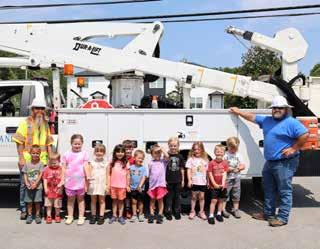
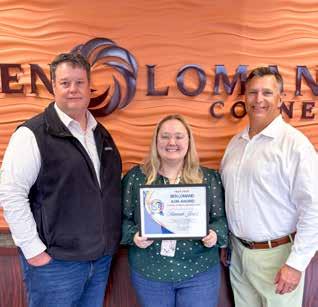
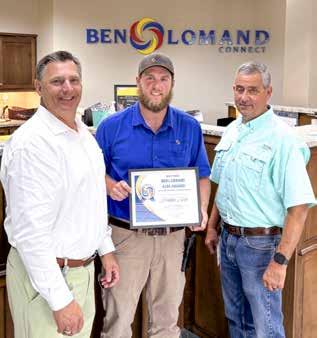


FStory by DREW WOOLLEY

all is the perfect time for travel and new experiences with family and friends. And while flying can have its conveniences, most travelers prefer to hit the road when mapping out their next adventure. According to AAA’s domestic travel forecast for a recent holiday weekend, 87% of travelers planned to make trips by car.
“I usually tend to drive, and most people choose to drive. And the reason for that is, for most families and groups of people, it’s the most affordable way to travel,” says AAA Texas Communications Manager Doug Shupe. “It’s also the most convenient. You can leave when you want to leave and return when you want to. But there definitely needs to be some preparation before taking a long road trip.”
Before everyone piles into the car, make sure you’re ready for the journey. That includes giving your vehicle a quick inspection, planning a route and having the supplies—and the tunes—to keep everyone happy until you reach your destination.
Before any lengthy road trip, Doug recommends taking your vehicle for a tuneup at a trusted repair facility. But if you can’t find time for that, it’s still a good idea to do a few quick checks on your own.


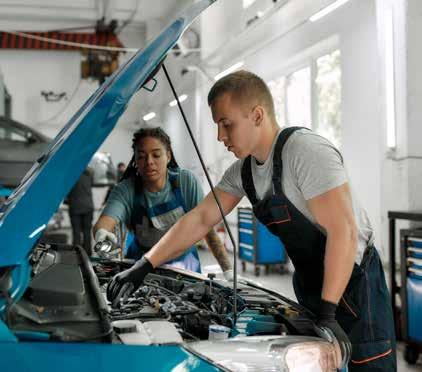

Check your tires to make sure they’re properly inflated and in good condition.
That includes the tread. If you can put an upside-down quarter in the grooves of your tires and see the top of George Washington’s head, it’s probably a good idea to replace them before taking a long trip.
If your vehicle’s battery is more than 3 years old, consider having it tested before getting on the road. Vibration can also cause a battery to fail sooner, so check that the terminals are secure and free of corrosion.
Examine your radiator and cooling system to make sure they’re in good condition. Check belts and hoses for cracks or fraying that could lead to problems after extended use.
Ensure your wiper blades are in good shape in case you pass through a rainy patch, and have someone help you check that your headlights, taillights and turn signals are all working properly.
One of the best parts of any road trip is mapping out a path, as long as there’s a little room for improvisation. Plan ahead and make the most of these tools
that can help you find the right stops along the way.
Know what’s coming—Apps like Roadtrippers and GasBuddy can help you pick the best place to make a pit stop. Get suggestions for must-visit restaurants and scenic drives or just scope out the most affordable gas prices so you can make the most of your detours.
Go analog—GPS is an invaluable resource on the road, but it’s still smart to have a physical map to orient yourself just in case you lose signal or your battery dies. Maps can even be a fun distraction for kids and give them a hands-on way to follow along with where you are.
Track your itinerary—If you’ve already set up all your reservations for hotels, restaurants and attractions, TripIt can keep track of it all in one place. The app syncs with your inbox to compile an itinerary, so you don’t have to search for each confirmation email, and sends you reminders so you can focus on having fun.
Don’t be afraid to rest—If you’re driving for multiple days, be realistic about how far you can go before resting for the night. It’s better to lean toward too many stops than too few. You can even pull over for a quick 30-minute nap if you’re feeling drowsy.
Hitting the open road also means getting to spend plenty of time with your favorite people. So don’t forget

to prepare the food, games and music that will help you make the most of it.
State of play—Road trip games are classic, from the Alphabet Game and I Spy to Two Truths and a Lie and 20 Questions. Make your own fun by taking turns thinking of a movie and describing it in the worst way possible to see who can guess it. Or, learn more about each other by picking a category like songs, books or foods and building your own top-five lists.
Fight the munchies—Stops at holein-the-wall restaurants are a must for

any road trip. But someone is bound to get hangry in between meals. Everyone’s favorite snacks will vary, but it’s hard to go wrong with some trail mix or jerky. You can even pack fruit and rice cakes for healthy options.

The perfect mix—Planning out a playlist that will make everyone happy is a tall task. You want music that will fit the mood and maybe even complement the terrain you’re driving through. Fortunately, you don’t have to do it alone these days. If everyone shares the same music service, you can make a shared playlist that everyone can contribute to. You can even make a game out of it, guessing who’s the secret Swiftie or where all those oldies came from.
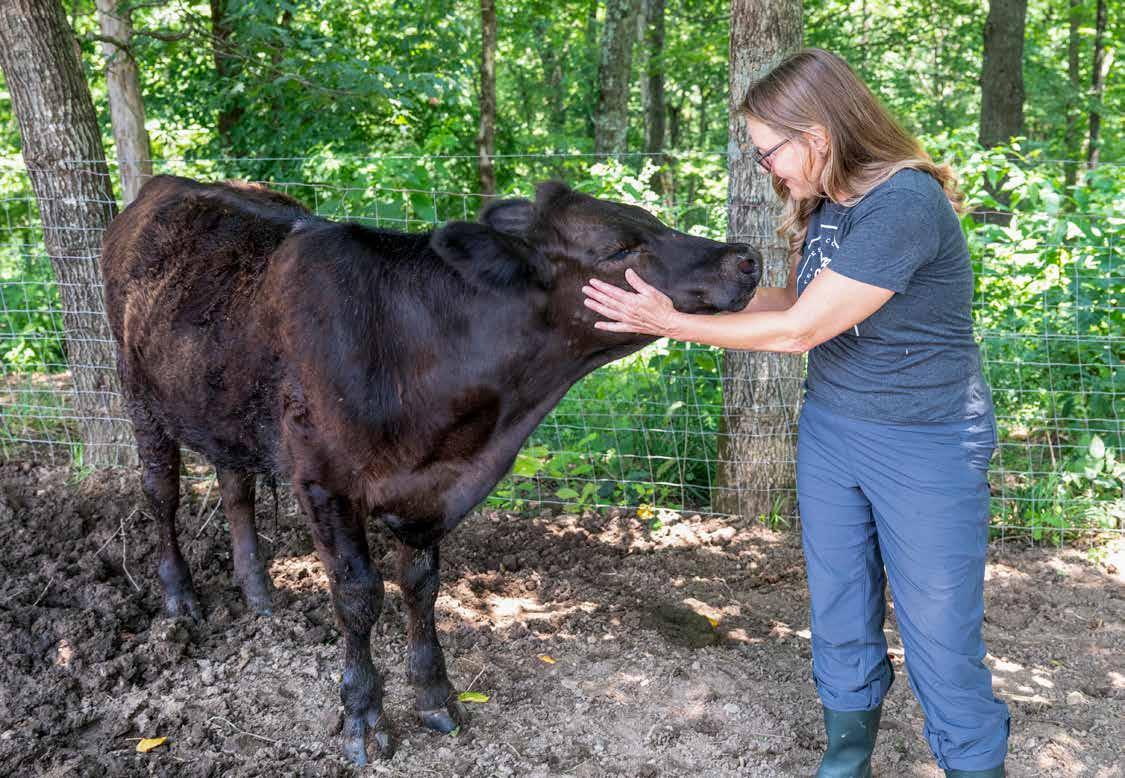
Story by MELANIE JONES
Denise Montrose can explain why the Tennessee Cow Rescue she founded is important by sharing the story of one cow.
Sanjay, a microminiature heritage calf, was only 2 days old when Denise got a call from his breeder. Sanjay’s leg was severely injured during a difficult birth, and standing was difficult for him. On top of that, his mother was also sick and had trouble standing long enough to allow Sanjay to nurse. The breeder had a bad back and couldn’t handle bottle-feeding the calf.
“The breeder called me, and she said, ‘You’ve got to come get this calf or it’s the
end of him,’” Denise says. “So, I jumped in my Volkswagen Passat, because I didn’t even have a truck yet, and I picked him up and brought him home. He was so small, he fit in a laundry basket.”
Sanjay was too small and frail to live outdoors on his own, so Denise and Buddha, her 160-pound sheepdog, shared space in their RV with him. “Buddha was like, ‘What in the world is going on?’” Denise says. “It was absolutely the craziest thing, but it was a lot of fun.”
Now Sanjay lives in a small pasture of his own, separated from the other cows because of his small size and disability. Denise moved a sheep into the pasture
with him to keep him company, and when calves new to the farm come out of quarantine, she’ll let them stay with Sanjay until they are big enough to go in the main pasture.
Sanjay is one of more than 50 cows Denise has rescued since 2021. More than 10 of them still live on her farm in Warren County. She takes in animals seized by authorities after being neglected or mistreated, and some farmers rehome their sick or injured animals with her.
Tennessee Cow Rescue began when Denise met Elizabeth, a Charolais cow
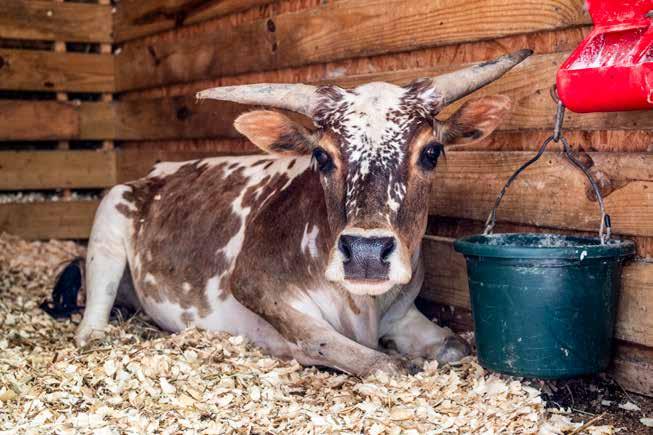

suffering from severe pink eye. Elizabeth was kept alone on land near Denise’s home, and Denise would stop and feed her an apple or just pet her almost every day.
Elizabeth’s owner wasn’t neglectful, Denise says. He was a young man working on another farm who brought her home when the owner of the Charolais farm didn’t want a bottle calf. The young man wanted to raise Black Angus, though, and was saving to start his own farm. Elizabeth just wasn’t part of his long-term plan.
Denise took pity on the cow and the young farmer. She offered to pay for a vet to come and treat Elizabeth’s eyes. Eventually, she decided to buy the cow. “But my homeowners’ association neighborhood wasn’t the place to keep her,” she says.
So, she set out on a trek across Middle Tennessee to find enough land to start Tennessee Cow Rescue. She found it in Warren County, but it didn’t—and still doesn’t—have a house. At first, she lived in an RV with Buddha. Then Sanjay
LEFT: Sanjay was so small when Denise brought him to the Tennessee Cow Rescue that he fit in a laundry basket.
moved in. Now, she has a garage on the property, and she lives in a cow-free apartment on the second floor. Once she has a house, Denise plans to use the garage apartment as a bed and breakfast so guests can learn what life is like on the farm and enjoy vegan meals.
Denise has rescued far more cows than she currently has on-site at Tennessee Cow Rescue because she has been able to rehome many of them. She makes sure the new owners have good pastures, sturdy fences with strong gates, and she determines that they aren’t going to slaughter the animal before she passes it on.
Some animal rescue operators, many of whom are vegans like Denise, refuse to work with farmers. But Denise says she has a good relationship with community farmers, though she opposes factory farming. She helps local farmers who ask her how to keep their cows safe and happy, and sometimes they donate hay bales or equipment they no longer need to the rescue in return.
Tennessee Cow Rescue wasn’t inspired just by veganism. “People ask me why I’m doing this,” she says, “and the only thing I can come up with is it’s the right thing to do.”
Because Tennessee Cow Rescue has internet service from Ben Lomand Connect, Denise has a website, tennesseecowrescue.org, to pique folks’ curiosity. She can also chat with interested donors or visitors who call 931-240-4079 or send an email to denise@tennesseecowrescue.org.
The farm welcomes visitors on most Saturdays. Tours are $20 per person and include a trip to the cave on the property, if desired. Anyone can book a time on the website’s visitor page. Volunteer and donation information is available at tcr.farm/donate.
Story by MELANIE JONES

Next morn'in just at daybreak
And beneath his horse, smashed to a pulp
His spur had rung his knell Was our little Texas Faithful, wrangl'in Joe
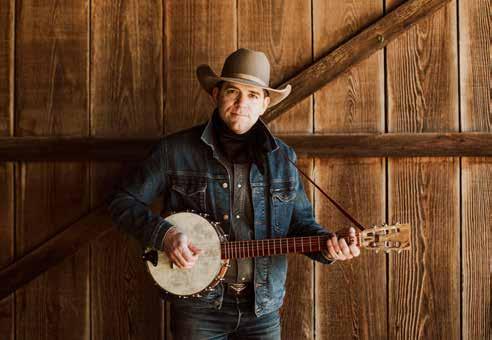
Acowboy poet, musician and podcaster, Andy Hedges collects oral histories of the Old West the way rodeo champs collect belt buckles. He’s a champion of cowboy culture, and he has the hat to prove it.
“I think there’s something about that image that just resonates with people,” he says. “They know cowboys represent some of the best of American values—independence, honesty, hard work. And when they hear it, they’re hearing real, authentic stories from cowboy culture. They learn the real truth behind the cowboy image.”
Cowboy poetry also extends to music, with songs like “Rounded Up in Glory” and “Little Joe the Wrangler.” Roy Rogers and Gene Autry brought that style of music to the silver screen, although the Hollywood version is not at the heart of the genre.
Authenticity inspires events across the country, from the Cowpoke Fall Gathering in Loomis, California, to Old West Days in Valentine, Nebraska. Minnesota annually declares a Cowboy Poetry Week, and Andy is returning to Jonesborough, Tennessee, where he performed several times. Cowboy music has even made it to the world-famous Carnegie Hall.
Andy, who lives in Lubbock, Texas, is part of a movement that began in 1985, when a group of cowboys met in Elko, Nevada, for the inaugural National Cowboy Poetry Gathering. It’s where cowboys swap tales, sing songs of the range and recite poetry that fills lonely days and nights.
What makes a poet a cowboy poet? Andy says his friend Vess Quinlan explains it this way: “He told me there’s two ways you can make a deposit in the cowboy poetry bank. One is by being a working cowboy who writes poetry. The other one is to be a noncowboy who writes poetry that is so good, it becomes accepted by working cowboys. And, of course, it has to be authentic. It has to ring true to those people.
“A lot of people write or recite cowboy poetry or sing the old cowboy songs or write new songs,” Andy says. “The truth is a lot
of us, including myself, have never made a living as a cowboy.”
Andy has spent years immersing himself in cowboy culture’s history, poetry and music. “I try really hard to represent the culture in an authentic way,” he says.
He grew up hearing stories of his dad, who worked the rodeo circuit before becoming a Primitive Baptist preacher. He watched old Hollywood Westerns and listened to Western music. “All I really thought I wanted to do was be a cowboy,” he says.
But his true obsession with cowboy culture began when he saw an episode of “Austin City Limits” featuring Michael Martin Murphy and friends. Those friends included cowboy poet Waddie Mitchell, cowboy singer Don Edwards and the groups Sons of the San Joaquin and Riders in the Sky. “It just opened that world up to me,” Andy says. “I didn’t realize there were people who still sang the old songs. I’d never heard cowboy poetry before I heard Waddie on that show.”
A self-taught guitarist, young Andy learned some of the old songs. “It was really the beginning of a lifelong obsession with cowboy poetry and cowboy songs,” he says.
By the time he could drive, the homeschooled teen was traveling to cowboy gatherings. By 20, he made it to Elko, where he’s appeared 17 times. Since recording his album of duets, “Ride On, Cowboy,” he and some of the album’s guests have appeared on the Grand Ole Opry and practiced, practiced, practiced their way to Carnegie Hall, where they performed for an appreciative audience in March 2024.
The music has an international audience. While travelers come to the United States for gatherings, some performers also toured overseas. Andy even traveled to Turkmenistan as part of a cultural exchange. “The cowboy has always been the folk hero of America,” he says. “People identify with that image. You know, when I traveled to Turkmenistan, or just travel overseas not performing, when I wear a cowboy hat, people love that and immediately associate that image with the United States.”
Cowboy poet and musician Andy Hedges will be the teller-inresidence at the National Storytelling Center in Jonesborough, Tennessee, Sept. 2-6. Andy has participated in the National Storytelling Festival before.
“It’s a really fantastic gathering of all kinds of storytellers from different traditions,” he says of the festival. “I was honored to be there representing the cowboy tradition and sharing cowboy poetry with them.” As teller-in-residence, he’ll perform a concert every day, make media appearances and take part in other community events. For more information on the event, go to storytellingcenter.net.
To learn more about cowboy culture, check out Andy’s podcast, “Cowboy Crossroads.” You can download episodes at andyhedges.com/cowboy-crossroads.

Story by MELANIE JONES
In June, Samantha Saldana and Jamison Helton joined dozens of students from across the country in Washington, D.C., for this year’s Foundation for Rural Service Youth Tour.
Since 1995, FRS has hosted the Youth Tour for thousands of high school students from across rural America. The tour is a chance for students to visit the nation’s capital, learn about rural broadband and share their community’s story with key legislative, regulatory and government figures. It is also a forum for participants to meet and interact with their peers from other rural communities.
Samantha and Jamison both listed visiting the national monuments and learning more about the history behind them among their favorite parts of the once-in-a-lifetime experience.
“It was amazing,” says Samantha, now a senior at Warren County High School, adding that the Washington Monument and Lincoln Memorial were her favorites.
“The monuments and memorials were crazy cool,” says Jamison, also a senior at Warren County. He was excited to learn people can climb inside the Washington Monument and was a little disappointed he didn’t get a chance to do so. He said he’d wanted to go to D.C.
and visit the Smithsonian museums for a long time, and this chance was exciting.
Both students jumped at the chance to apply when they learned about the tour. “I’ve always been a history buff,” Jamison says of one reason he applied.
“I was thrilled,” Samantha adds.
A visit to the Federal Communications Commission was high on the list of activities, as the trip is designed to introduce participants to the issues facing telecommunications industry and telecom cooperatives.
Samantha says she learned many things at the FCC and found the visit fascinating. There, the students learned about how America would protect its telecommunications system from cyberattack as well as general fail-safes and the next big thing after fiber optics and satellites, though there’s several possibilities there, Jamison says.
Both teens formed bonds on the trip they hope will last a lifetime. “Making new friends was amazing,” Jamison says. “My roommate was great, and that might not happen for every kid.”
Samantha also established friendships on the trip. “I met a lot of new people, and it was cool.”


Story by MELANIE JONES
Curious about the history of Spencer? Then head into town Oct. 24-25, hop on the back of a trailer and take a ride through downtown and the Spencer Cemetery. Along the way you’ll hear not only about the history of the town and Van Buren County, but also local legends and tall tales.
Tour guide Abby Sullivan recounts the history of the town and the surrounding area, and sometimes tourgoers offer insights of their own. For example, Abby says last year, when she was talking about the history of the town’s 911 building, housed on site of the Old Bouldin Hotel, a dispatcher spoke up to share that he’d had creepy encounters there. A woman who worked in the Burritt College building also reported an eerie feeling when she was upstairs alone at night.
Although the tours take place near Halloween, Abby and Mika Davis, of the Van Buren-Spencer Chamber of Commerce, say they’re more about history than chills and thrills.
“We try to keep it as PG as possible,” Abby says. Mika agrees, adding the tours are designed for all ages, provided children are accompanied by a parent or guardian. She even took her then-1year-old on the tour’s inaugural run last year.
Abby and Mika started the tour because there was nothing else like it around. Abby visits cities across the United States and loves taking history tours wherever she goes. So, she talked to the chamber leaders about starting Spencer’s own. Mika quickly hopped on board. “There’s a ton of history in this town,” she says, “and many residents don’t know anything about it.”
The cemetery portion of the tour is strictly contained to the historical side of the property, which Mika says dates back almost 200 years.
Abby and Mika say the tour had overwhelming support in its first year. “We were blown away,” Mika says. They had to add

Sullivan leads tours Oct. 24-25.
an extra hourlong tour and still had to turn people away. So, this year they expanded it into a two-day event, starting at 5 p.m. on Oct. 24-25. That coincides with the county fair, giving fairgoers something else to do while they’re out and about.
The cost of the tour is $10, and the money goes to the chamber to pay for future events.
History isn’t the only thing on the Van Buren-Spencer Chamber of Commerce’s schedule this Halloween season. The Trail of Treats also takes place on the Saturday of the history tour.
The chamber’s Mika Davis says the group established the Trail of Treats as another way for children to safely collect their sweet Halloween loot.
Businesses and individuals set up booths and give away candy on the Trail of Treats. They encourage trick-or-treaters to dress in their costumes, even though Halloween will be nearly a week away. Scary costumes are acceptable, and the costume contest on Oct. 25 will be a big draw.

Do you ever crave an easy meal with meat and vegetables? Try putting kabobs on the menu. It’s a tasty grill-friendly choice, and cleanup is easy.
Begin with a tender cut of meat like top sirloin, which is affordable. Filet also works well. If you’d like, substitute chicken or tofu. Just remember to cut your protein portions to about the same size so they cook evenly. You can add as many chopped veggies as you like.
Begin with a fresh marinade. Homemade chimichurri does double duty as a marinade and seasoning sauce––it works for any protein. Round out your meal with crunchy Asian coleslaw and a fresh apple cake for dessert.
CHIMICHURRI SAUCE
1/2 cup fresh cilantro, packed, leaves and tender stems
1/2 cup fresh parsley, packed
3 tablespoons fresh oregano or 3 teaspoons dried
1 lemon, zested and juiced
3-4 cloves of garlic
1/2 cup extra-virgin olive oil
3 teaspoons red wine vinegar
1 teaspoon crushed red pepper
1/2 teaspoon kosher salt
Put all ingredients in a food processor
and pulse until blended. Taste and season with salt and pepper as desired.
STEAK KABOBS
32 ounces top sirloin, or the protein of your choice, cut into 2-inch cubes
36-48 baby potatoes, golden or mini reds
2 medium bell peppers, any color, chopped into 2-inch pieces
2 small red onions, chopped into 2-inch pieces
Kosher salt and ground black pepper

1 cup oil
2 cups sugar
3 eggs
2 1/2 cups flour
1 teaspoon salt
2 teaspoons baking powder
1 teaspoon cinnamon
1 teaspoon vanilla
1 cup pecans or walnuts, chopped
3 cups apples, peeled and chopped
1 8-ounce package cream cheese, softened
16 ounces powdered sugar
After reserving some of the chimichurri to use during cooking and for dipping the cooked kabobs, combine the rest of the sauce and the cubed protein in a sealable bag. Set aside to marinate. Meanwhile, soak the skewers in water a minimum of 20 minutes so they don't burn on the grill. Add potatoes to a large pot, cover with water and 2 teaspoons of salt. Boil for 5-7 minutes or until fork tender. Drain and rinse the potatoes. Let them sit in cold water to cool. Chop veggies and have them ready to slide onto your skewers. Now it’s time to assemble: Using a soaked skewer, put either a potato or piece
2 packages ramen noodles, any flavor
2 16-ounce packages shredded coleslaw mix
1 cup slivered almonds, toasted
5 green onions, chopped
1/2 cup sugar
1/2 cup vegetable oil
1/3 cup rice vinegar
Reserve the flavor packets from the noodles for another use or toss. Crush the
noodles and set aside. Toss together the coleslaw mix, almonds and green onions in a large salad bowl.
Whisk together the sugar, oil and vinegar in a small bowl until mixed. Add the dressing to the coleslaw mixture and toss to coat. Mix in the chopped noodles. Serve immediately. Makes 12 servings.
Note: You may prepare the salad in advance, adding the noodles just before serving so they are crunchy.
8 tablespoons butter
2 teaspoons vanilla
Measure oil into a large bowl, then whisk in sugar and eggs.
Mix together the flour, salt, baking powder and cinnamon, then add to the creamed mixture, beating well. Add vanilla, then fold in nuts and apples.
Pour mixture into a greased 9-by-13-inch pan. Bake at 350 F for 50 minutes or until cake tests done. Cover with foil if it gets too dark around the edges.
To make frosting: Combine all frosting ingredients and spread over cooled cake.
of meat on first, so the rest of the veggies don’t slide off the end. Then alternate between meat, potatoes and veggies. Prepare the grill to about 500 F. Once it’s ready, place steak kabobs perpendicular to the grill grates. Grill 3 minutes on each side for medium doneness. If you use chicken, cook for 5-7 minutes. Tofu needs to cook about 10 minutes. While cooking, brush the reserved chimichurri on the kabobs. Remove the kabobs from the grill and let rest for 3-5 minutes. Use the chimichurri as an extra dipping sauce, if desired.







